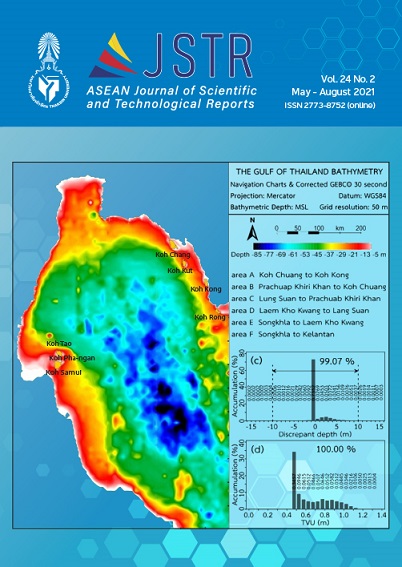Effect of Fermented Napier Grass Mixed with Acid Fermented Milk Diet on Nile Tilapia in Cage Culture
Main Article Content
Abstract
Aquatic animal feed is a key to the growth of aquatic animals, and the raw materials affect production costs. The use of fermented Napier grass mixed with acid fermented milk for Nile tilapia (Oreochromis niloticus). After it was found that the weights of the fishes were increased. ,the daily weight gain and specific growth rates were significantly different (p < 0.05). Among treatments the fish fed with the fermented napier grass at the level of 10 percent had the highest body weight of 55.12 ± 3.90 grams. The survival rates and feed conversion rate were non-significantly different (p > 0.05). Therefore, it could be concluded that the acid fermented milk diet mixed with fermented napier grass at the level of 10 percent could be used for producing the feeds for Nile tilapia.
Article Details

This work is licensed under a Creative Commons Attribution-NonCommercial-NoDerivatives 4.0 International License.
References
Plaipetch, P. (2016). Nutritional management for culturing Nile Tilapia (Oreochromis niloticus). Science and Technology Journal, 24(1), 13–39.
Simawan, J., Mongkolvai, P., & Sriphuthorn, K. (2016). The effect of utilization of tomato pomace in diets on growth performance and digestibility of Nile Tilapia (Oreochromis niloticus), Khon Kaen Agriculture Journal. 44, Supplement (1), 688–693.
Inthamnu, A. (2015). Effects of enrichment with chopped fresh Napier, Napier silage, and Napier pellet on behavior and stress of sows in individual stalls. Doctoral Dissertation. Suranaree University of Technology.
Liangco, N.C., Reyes, J.L., Gaffud, O.M., Pascua, E.M., Jamsawat, V., & Seatung, C. (2019). Study on chemical composition of super Napier grass silage treated with Lactobacillus Buchneri and Lactobacillus Plantarum. Journal of Mycology & Mycological Sciences, 2(2), 1–6.
Chukwannuan, W., Jitmanowan, S., & Tongsiri, S. (2017). Growth performances of Nile Tilapia (Oreochromis niloticus) fed with diet, Journal of Fisheries Technology Research. 11(2), 11–19.
Keidskul, M. & Lekchairas, T. (2013). Producing Napier Pak Chong1, Aquatic Journal, 24(285), May, 110–114.
National Bureau of Agricultural Commodity and Food Standards (ACFS). (2010). Raw Cow Milk. Bangkok: Ministry of Agriculture and Cooperatives.
Rotmongkoldee, M., Leelapat, W., & Thaimuangphol, W. (2017). Effect of probiotics on growth performance and survival rate in Anabas testudineus. Science and Technology Journal. Ubon Ratchathani University (Special Issue), July, 82–89.
khiewtong, k. (2011). Napier grass planting guide, Pakchong 1. Nakhon Ratchasima: Nakhon Ratchasima Animal Food Research and Development Center.
Jaided, P., & Noppakeua, S. (2001). Mooo milk.(Acid fermented milk). Publication (TRF Dairy Newsletter), Research and Development Network Coordination Office, Faculty of Veterinary Science Chulalongkorn University, Bangkok, 5(4), 12–14.
Sermwattanakul, A., Somsueb, P., Thongsri, N., & Wongsuwan, S. (2005). Food and aquaculture production. Bangkok: Ministry of Agriculture and Cooperatives.
Pongjanyakul, T., Namueangrak, N., Songaresa, P., & Jongngam, C. (2010). Alternation feeding of low protein and high dietary level of black ear catfish (Pangasius larnaudii Bocourt, 1866). Ubonratchathani: Ubonratchathani Inland Fisheries Research and Development Center.
Sangeetha, S., & Rajendran, K. (2019). Growth of grass carp Ctenopharyngodon idella fed on hybrid Napier grass (CO-3) mixed diet. Journal of Drug Delivery and Therapeutics, 9(4-A), 151–154.
Lounglawan, P. (2015). Effect of Lactobacillus spp. on silage fermentation. Nakhon Ratchasima: Suranaree University of Technology.
Keereelang, J., Mongkolthep, W., Chaipien, P., & Tongsiri, S. (2018). A study of the In Vitro digestibility in feed ingredients of Nile Tilapia (Oreochromis niloticus). In The 5th Conference on Research and Creative Innovation, 112–123, December 6-7, 2018, Tak: Rajamangala University of Technology Lanna.
Klahan, R., Areechon, N., Yoonpundh, R., & Engkagul, A. (2008). Digestive enzyme activity in various Sizes of Nile tilapia (Oreochromis niloticus, L.). Journal of fishery Technology research, 2(2), 33–43.
Gemechu, T. (2015). Review on lactic acid bacteria function in milk fermentation and preservation. African Journal of Food Science, 9(4), 170–175.
Silalaiy, K. (2018). Probiotics: The advantage in livestock. King Mongkut’s Agriculture Journal, 36(1), 152–160.
Allameh, S.K., Noaman, V., & Nahavandi, R. (2017). Effects of probiotic bacteria on fish performance. Advanced Techniques in Clinical Microbiology, 1(2:11), 1–5.
Opiyo, M. A., Jumbe, J., Ngugi, C. C., & Charo-Karisa, H. (2019). Different levels of probiotics affect growth, survival and body composition of Nile tilapia (Oreochromis niloticus) cultured in low input ponds. Scientific African, 4 (2019), 2–7.
Dowidar, M. F., ElAzeem, S.A., Khater, A. M., Awad, S.M., & Metwally, S. A. (2018). Improvement of growth performance, immunity and disease resistance in Nile tilapia, Oreochromis niloticus, by using dietary probiotics supplementation. Journal of Animal Science and Veterinary Medicine, 3(2), 35–46.
Fakhri, M., Ekawati, A. W., Arifin, N.B., Yuniarti, A., & Hariati, A.M. (2019). Effect of probiotics on survival rate and growth performance of Clarias gariepinus. Nature Environment and Pollution Technology, 18(1), 313–316.
Joshua, E.O., & Adogbeji, E.P. (2017). Factors affecting feed in take in cultured fish species: A review. Animal Research International, 14(2), 2697–2709.

